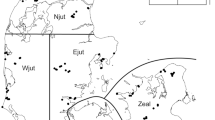Abstract
Large-scale biodiversity informatics projects will not properly address the needs of one important potential user group. Ecologists do not have ready access to datasets which allow them to assign plant species to functional types. We believe that information technology has developed sufficiently to allow taxonomists and ecologists to work together to address this need and develop specimen databases to combine taxonomic data with ecological and ecophysiological information so that this information will be assigned to the correct taxon in the future. Digital images provide a rapid and economical method of vouchering specimen data, reducing the need to store physical vouchers in herbaria.

Similar content being viewed by others
References
Boutin C, Keddy PA (1993) A functional classification of wetland plants. J Veg Sci 4:591–600
Brooks JR, Flanagan LB, Buchmann N et al (1997) Carbon isotope composition of boreal plants: functional grouping of life forms. Oecologia 110:301–311
Díaz S, Cabido M (1997) Plant functional types and ecosystem function in relation to global change. J Veg Sci 8:463–474
Díaz S, Hodgson JG, Thompson K et al (2004) The plant traits that drive ecosystems: Evidence from three continents. J Veg Sci 15:295–304
Gitay H, Noble IR (1997) What are functional groups and how should we seek them? In: Smith TM, Shugart TM, Woodward FI (eds) Plant functional types: their relevance to ecosystem properties and global change, International Geosphere-Biosphere Programme Book Series 1. Cambridge University Press, Cambridge, pp 3–19
Gourlet-Fleury S, Blanc L, Picard N et al (2005) Grouping species for predicting mixed tropical forest dynamics: looking for a strategy. Ann For Sci 62:785–796
Grime JP (2002) Declining plant diversity: empty niches or functional shifts? J Veg Sci 13:457–460
Lavorel S, McIntyre S, Landsberg J et al (1997) Plant functional classifications: from general groups to specific groups based on response to disturbance TREE 12:474–478
Neale S, Pullan M (2005) User interface requirements analysis for the BioCASE/Synthesys biological information portal. Synthesys Networking Activity D Deliverable D 3.4.1 http://www.synthesys.info/NA_Documents/Deliverables/NA%20D/D3.4.1%20User%20interface%20requirements%20analysis.doc. Cited 9 September 2005
Neale S, Pullan M, Watson M (2005) User requirements and interface testing documents of natural history collection and biodiversity online portal projects. BioCASE/ Synthesys report. http://www.synthesys.info/NA_Documents/Deliverables/NA%20D/D3.4.1%20User%20interface%20requirements%20analysis.doc. Cited 9 September 2005
Picard N, Franc A (2003) Are ecological groups of species optimal for forest dynamics modelling? Ecol Model 163:175–186
Petchey OL, Gaston KJ (2006) Functional diversity: back to basics and looking forward. Ecol Lett 9:741–758
Skarpe C (1996) Plant functional types and climate in a southern African savanna. J Veg Sci 7:397–404
Smith TH, Shugart HH, Woodward FI (eds) (1997) Plant functional types: their relevance to ecosystem properties and global change. Cambridge University Press, Cambridge
Tilman D (1988) Plant strategies and the dynamics and structure of plant communities. Princeton University Press, Princeton
Whitfield J (2006) The cost of leafing. Nature 444:539–541
Acknowledgements
We wish to dedicate this paper to the memory of John Proctor, an ecologist with a keen appreciation of Toxonomy, and we hope that he would approve of the ideas expressed here. We would like to thank the anonymous reviewers whose comments were so useful in preparing the final version of this article.
Author information
Authors and Affiliations
Corresponding author
Rights and permissions
About this article
Cite this article
Pendry, C.A., Dick, J., Pullan, M.R. et al. In search of a functional flora—towards a greater integration of ecology and taxonomy . Plant Ecol 192, 161–167 (2007). https://doi.org/10.1007/s11258-007-9304-y
Received:
Accepted:
Published:
Issue Date:
DOI: https://doi.org/10.1007/s11258-007-9304-y




